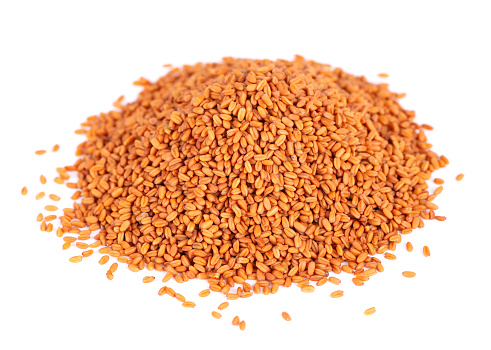
Camelina sativa oil
Oil extraction
In order to obtain gold of pleasure oil (Camelina sativa oil), its seeds, which contain about 30-40% oil, must be pressed. For this there are two possibilities, on the one hand by cold pressing with the help of a screw press / oil press, and on the other hand by an extraction. Extraction yields a little more oil, but it also destroys important and valuable substances contained in the seeds.
The seeds are cleaned and dried. Furthermore, the seeds are gently preheated to the pressing temperature. If the storage temperature is sufficient for mechanical pressing, the seeds are not preheated before pressing. The thus pretreated seed is added to a oil press for mechanical pressing. Gentle and efficient pressing of gold-of-pleasure seeds is carried out, for example, by means of a Florapower universal press, which de-oils the seeds both gently in cold pressing processes and particularly efficiently in hot pressing processes.
Or to obtain the oil, the seeds are first ground to a coarse mass. This sandy mass is then mixed with the same volume of water, then roasted at about 60-90° C and pressed in the next step. The oil is left to stand and then filtered through gauze. However, the keeping time of the oil is relatively short, which is due to the high content of unsaturated fatty acids in the oil. Therefore, further processing of the seeds is done just before sale.
Ölpressen für die Verarbeitung von Leindottersamen
Characteristics and shelf life
Camelina seed oil is a semi-drying oil whose color varies from light yellow to golden yellow to light orange. It exhibits a green, herbaceous, pyrazine and slightly citrus scent, which is often reminiscent of a freshly cut meadow. Taste-wise, the oil is described as slightly spicy and reminiscent of mustard seed oil. In color and in taste, it is somewhat similar to rapeseed oil. The oil solidifies around -18 to -11°C. In contrast, at room temperature it is liquid, yet dries relatively quickly.
The fatty acid composition of camelina oil is largely made of unsaturated fatty acids, the largest portion of which is α-linoleic acid (around 37.8%). Also present are oleic acid (13.4%), linoleic acid (16%) and erucic (about 2.76%); as well as eicosenoic acid (5.33%), palmitic acid, and stearic acid (around 2-3%). Beyond this range of fatty acids, the oil also contains many volatile substances, such as various alcohols and organic acids, sterols, and tocopherols, among others. The high portions of Vitamin E and γ-tocopherol are of particular importance. The high percentage of unsaturated fatty acids in camelina oil, however, unfortunately also account for its relatively brief shelf life.
Use
In the pharmaceutical and medical industries
Studies have shown (see the Lexikon der pflanzlichen Fette und Öle) that regular consumption of camelina oil increases the portion of α-linoleic acid in serum lipids while simultaneously reducing cholesterol. Furthermore, camelina oil can yield wax esters, which in turn represent potential fundamental substances for special lubricants in technology and for certain applications in the realm of cosmetics and of pharmacy. Camelina oil also seems to have a beneficial effect on arteriosclerosis, since it has a very good ratio of omega-3 and omega.6 fatty acids. This oil further represents a good source of omega-3 fatty acids –which are important for the human body –and therefore constitutes a fine alternative to fish oil. The high α-linoleic acid content in camelina oil, moreover, is considered valuable in the cosmetic realm and is thus used in the production of oils, creams, lotions, soaps, and so on.
In folk medicine
Camelina oil has long been used in the area of folk medicine. It is supposed to strengthen the immune system and also have a pain-relieving, antiseptic and wound-healing effect. It is used to help against various ailments and diseases, such as stomach and intestinal ulcers, gastritis, colic, digestion problems, bruises and bruising, skin abrasions, sprains, contusions, skin diseases, acne, inflammations, and frostbite, among other things. Even in the treatment of animals, it finds application, such as in trichophytia- or wound treatment.
In industry
Camelina oil also has a variety of industrial applications. It aids in the production of soaps and paints, for example. Additionally, it serves in the manufacture of luminous, soot-free lamp oil. This oil is also readily used in oleochemistry in order to produce environmentally friendly polymers, lacquers, varnish (with linseed oil), and paints, since camelina oil, on account of its high polyunsaturated fatty acid content, ranks among the quick-drying oils.
In the kitchen
In the kitchen, camelina oil can be used interchangeably with linseed oil. It is especially valued for cold dishes, yet should not be heated. From a nutritional perspective, the high α-linoleic acid content and the low amount of erucic acid (< 4%) are of special importance.
The press cakes, which are formed during the pressing of camelina seeds, can be used too, yet in Germany the use of camelina seed press cakes in animal feed is not currently allowed. This is due to the constant contamination of imported camelina seeds over the past years. However, in the near future, this ban could possibly soon be reversed using a re-assessment of imported press cakes. Generally the residual oil content in the cakes is around 8 to 17%. The portion of glucosinolate, tannins, and sinapine are relatively low, making it harmless as animal feed. The phytic acid and its product, inositol pentaphosphate, occur however in somewhat larger amounts. In addition, the cakes also contain small amounts of sinapine and tannins (comparable to soy protein).
In addition to their own knowledge acquired through press trials, the following sources were used to create the article:
- Öle, natürlich kaltgepresst, Basiswissen & Rezepte, Marcus Hartmann, Hädecke, 2008
- Heilende Öle, Pflanzenöle als Nahrungs- und Heilmittel, Neue Erkenntnisse, Günter Albert Ulmer Verlag Tuningen
- Lexikon der pflanzlichen Fette und Öle, Krist, Buchbauer, Klausberger, SpringerWienNewYork, 2008
- www.wikipedia.de
- en.wikipedia.org


